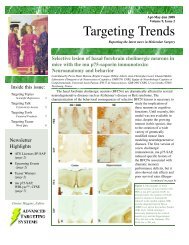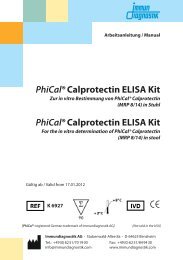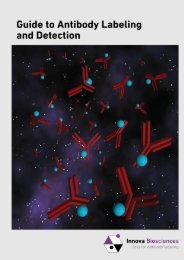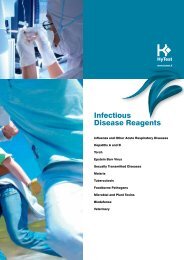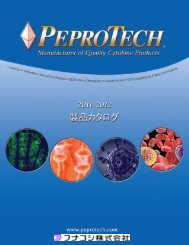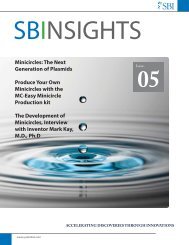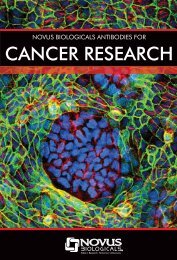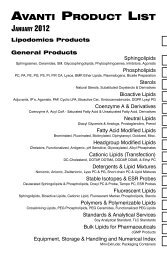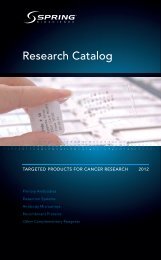Thermo Scientific Pierce Crosslinking Technical Handbook
Thermo Scientific Pierce Crosslinking Technical Handbook
Thermo Scientific Pierce Crosslinking Technical Handbook
Create successful ePaper yourself
Turn your PDF publications into a flip-book with our unique Google optimized e-Paper software.
Pyridyl disulfides<br />
Pyridyl disulfides react with sulfhydryl groups over a broad pH<br />
range (optimal pH is 4-5) to form disulfide bonds and, therefore,<br />
conjugates prepared using these reagents are cleavable. During<br />
the reaction, a disulfide exchange occurs between the molecule's<br />
–SH group and the 2-pyridyldithiol group. As a result, pyridine-<br />
2-thione is released and its concentration can be determined by<br />
measuring the absorbance at 343 nm (Figure 10). These reagents<br />
can be used as crosslinkers and to introduce sulfhydryl groups into<br />
proteins. The disulfide exchange can be performed at physiological<br />
pH, although the reaction rate is slower. (See Table 4 for available<br />
pyridyldithiol crosslinkers.)<br />
Sulfhydrylcontaining<br />
molecule<br />
Pyridyl disulfide<br />
compound<br />
Disulfide bond<br />
Pyridine<br />
2-thione<br />
Figure 10. Pyridyl disulfide reaction scheme. Reaction efficiency can be<br />
monitored by determining the concentration of the released pyridine-2-thione<br />
by measuring the absorbance at 343 nm (molar extinction coefficient at<br />
343 nm = 8.08 x 10 3 M -1 cm -1 ).<br />
Table 4. <strong>Thermo</strong> <strong>Scientific</strong> <strong>Pierce</strong> Pyridyl Disulfide Crosslinkers.<br />
Reagent Reactivity Product #<br />
LC-SPDP Sulfhydryl/Amine 21651<br />
Sulfo-LC-SPDP Sulfhydryl/Amine 21650<br />
PDPH Sulfhydryl/Carbohydrate 22301<br />
Carboxyl-reactive chemistry<br />
Carbodiimides<br />
Carbodiimides couple carboxyls to primary amines or<br />
hydrazides, resulting in the formation of amide or hydrazone<br />
bonds. Carbodiimides are unlike other conjugation reactions<br />
in that no spacer exists between the molecules being coupled.<br />
Carboxy termini of proteins can be targeted, as well as glutamic<br />
and aspartic acid side chains. In the presence of excess crosslinker,<br />
polymerization is likely to occur because all proteins<br />
contain carboxyls and amines. The bond that results is the same<br />
as a peptide bond, so reversal of the conjugation is impossible<br />
without destroying the protein.<br />
EDC (Product # 22980, 22981) reacts with carboxylic acid group<br />
and activates the carboxyl group to form an active O-acylisourea<br />
intermediate, allowing it to be coupled to the amino group in the<br />
reaction mixture. An EDC byproduct is released as a soluble urea<br />
derivative after displacement by the nucleophile (Figure 12).<br />
The O-acylisourea intermediate is unstable in aqueous solutions,<br />
making it ineffective in two-step conjugation procedures<br />
without increasing the stability of the intermediate using<br />
N-hydroxysuccinimide. This intermediate reacts with a primary<br />
amine to form an amide derivative. Failure to react with an amine<br />
results in hydrolysis of the intermediate, regeneration of the<br />
carboxyls and the release of an N-unsubstituted urea. The crosslinking<br />
reaction is usually performed between pH 4.5 to 5 and<br />
requires only a few minutes for many applications. However, the<br />
yield of the reaction is similar at pH from 4.5 to 7.5.<br />
Carbonyl-/Glyco-reactive chemistry<br />
Hydrazides<br />
Carbonyls (aldehydes and ketones) react with hydrazides and<br />
amines at pH 5-7. The reaction with hydrazides is faster than<br />
with amines, making them useful for site-specific crosslinking.<br />
Carbonyls do not readily exist in proteins; however, mild oxidation<br />
of sugar glycols using sodium meta-periodate will convert vicinal<br />
hydroxyls to aldehydes or ketones (Figure 11). The oxidation is performed<br />
in the dark at 0-4°C to prevent side reactions. Subsequent<br />
reaction with hydrazides results in formation of a hydrazone bond.<br />
Carbohydrate modification is particularly useful for antibodies in<br />
which the carbohydrate is located in the Fc region away from binding<br />
sites. At 1 mM NaIO 4 and a temperature of 0°C, the oxidation<br />
is restricted to sialic acid residues. At concentrations of 6-10 mM<br />
periodate, other carbohydrates in proteins (including antibodies)<br />
will be targeted.<br />
Oxidation of a carbohydrate (cis-diol) to an aldehyde<br />
A.<br />
B.<br />
Carboxylate<br />
containing<br />
molecule<br />
o-Acylisourea<br />
reactive ester<br />
EDC<br />
Figure 12. EDC coupling reaction scheme.<br />
Amide bond<br />
o-Acylisourea<br />
reactive ester<br />
Urea<br />
The hydrolysis of EDC is a competing reaction during coupling<br />
and is dependent on temperature, pH and buffer composition.<br />
4-Morpholinoethanesulfonic acid (MES, Product # 28390) is an<br />
effective carbodiimide reaction buffer. Phosphate buffers reduce<br />
the reaction efficiency of the EDC, but increasing the amount of<br />
EDC can compensate for the reduced efficiency. Tris, glycine and<br />
acetate buffers may not be used as conjugation buffers.<br />
Aldehyde-containing<br />
molecule<br />
Hydrazide<br />
compound<br />
Figure 11. Hydrazide reaction scheme.<br />
Hydrazone linkage<br />
To order, call 800-874-3723 or 815-968-0747. Outside the United States, contact your local branch office or distributor.<br />
19



